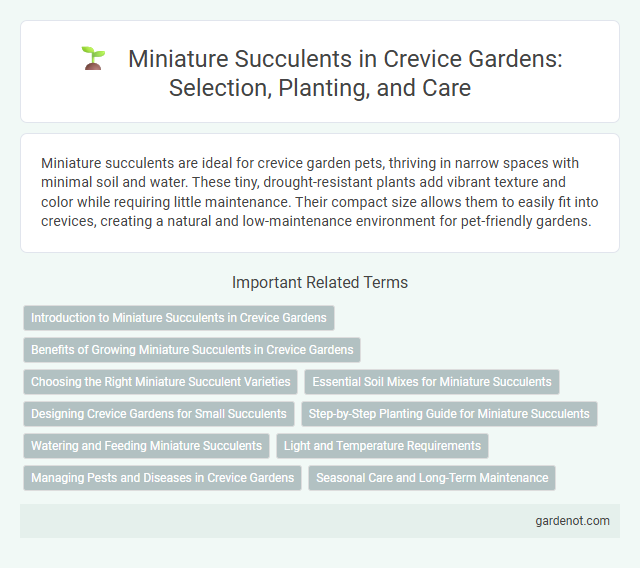Miniature succulents are ideal for crevice garden pets, thriving in narrow spaces with minimal soil and water. These tiny, drought-resistant plants add vibrant texture and color while requiring little maintenance. Their compact size allows them to easily fit into crevices, creating a natural and low-maintenance environment for pet-friendly gardens.
Introduction to Miniature Succulents in Crevice Gardens
Miniature succulents are ideal for crevice gardens due to their compact size and ability to thrive in narrow, rocky spaces with well-drained soil. These small plants, including species like Sedum and Sempervivum, exhibit drought tolerance and slow growth, making them perfect for tight, vertical environments. Their unique water-storing tissues and rosette formations allow them to flourish while adding textured greenery to crevice garden designs.
Benefits of Growing Miniature Succulents in Crevice Gardens
Miniature succulents thrive in crevice gardens due to their ability to adapt to narrow spaces and retain moisture efficiently, promoting low-maintenance care. Their compact size enhances the aesthetic appeal by filling small gaps with vibrant texture and color, creating a visually dynamic landscape. These succulents also improve soil stability and require minimal watering, making them ideal for sustainable and drought-resistant garden designs.
Choosing the Right Miniature Succulent Varieties
Selecting the right miniature succulent varieties such as Echeveria, Sedum, and Haworthia ensures optimal growth in crevice gardens due to their compact sizes and drought tolerance. These species thrive in narrow, rocky spaces with well-draining soil and minimal water, making them ideal for crevice conditions. Prioritize varieties with shallow root systems and slow growth rates to maintain the delicate balance and aesthetics of a crevice garden environment.
Essential Soil Mixes for Miniature Succulents
Essential soil mixes for miniature succulents emphasize excellent drainage and aeration, typically combining components like coarse sand, perlite, and cactus potting soil. A balanced mix with these ingredients prevents root rot by avoiding water retention while providing necessary nutrients. Incorporating organic matter such as coconut coir or peat moss enhances moisture retention without compromising drainage, ideal for crevice garden environments.
Designing Crevice Gardens for Small Succulents
Miniature succulents thrive in crevice gardens designed with narrow, deep gaps that mimic their natural rocky habitats, providing optimal drainage and protection from excessive moisture. Selecting small, drought-tolerant species such as Lithops, Haworthia, and Echeveria enhances the garden's visual appeal and ensures healthy growth within confined spaces. Incorporating well-draining, gritty soil mixtures and arranging succulents at different heights maximizes airflow and sunlight exposure critical for their development.
Step-by-Step Planting Guide for Miniature Succulents
Plant miniature succulents in a well-draining crevice garden by first selecting small, shallow crevices filled with gritty soil to mimic their natural habitat. Gently place each succulent in the crevice, ensuring the roots are fully covered and the base is stable. Water sparingly after planting, allowing the soil to dry completely between waterings for optimal growth and root health.
Watering and Feeding Miniature Succulents
Miniature succulents in crevice gardens require minimal watering, typically once every two to three weeks, allowing the soil to dry completely between sessions to prevent root rot. Use a balanced, diluted succulent fertilizer during the growing season, applying it monthly to support healthy growth without overwhelming their delicate root systems. Proper watering and feeding practices ensure vibrant, resilient miniature succulents that thrive in narrow, rocky crevices.
Light and Temperature Requirements
Miniature succulents in crevice gardens thrive under bright, indirect sunlight with exposure averaging 4 to 6 hours daily to prevent leaf scorching while promoting healthy growth. These plants prefer temperatures between 60degF and 80degF, tolerating brief dips to 45degF but requiring protection from frost and extreme heat above 90degF. Maintaining consistent light intensity and moderate temperatures ensures optimal photosynthesis and prevents stress-related issues in miniature succulent species.
Managing Pests and Diseases in Crevice Gardens
Miniature succulents in crevice gardens require vigilant pest management to maintain plant health and aesthetic appeal. Common pests such as aphids, mealybugs, and spider mites can be controlled using neem oil or insecticidal soap applied during early infestation stages. Proper air circulation and well-draining substrate prevent fungal diseases, minimizing the risk of root rot and powdery mildew in these compact garden setups.
Seasonal Care and Long-Term Maintenance
Miniature succulents in a crevice garden require precise seasonal care, including reduced watering during winter dormancy and increased hydration in spring growth periods to prevent root rot and dehydration. Long-term maintenance involves monitoring soil drainage and occasional fertilization with low-nitrogen, cactus-specific fertilizers to sustain growth and compact form. Proper pruning and removal of dead leaves enhance airflow and reduce pest or fungal issues, ensuring the succulents remain vibrant year-round.
Miniature succulent Infographic

 gardenot.com
gardenot.com